Understanding Peroxisomes, Diversity, Forms, Reactions & Functions
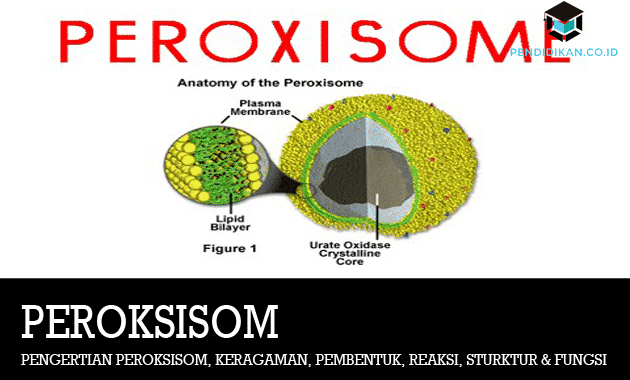
Understanding Peroxisomes (Peroxysomes)
This peroxisome (peroxysome) is an ancient organelle that has or has carried out all oxygen metabolism in primitive eukaryotic cells. The oxygen produced by the photosynthetic bacteria will then be accumulated in the atmosphere. This of course will cause the oxygen to be toxic from some cells.
This peroxisome is one of the organelles that is enclosed by a single membrane of coated lipids and also contains absorbing proteins (receptors). These peroxisomes have a task in reducing (oxygen) contained in cells and also carry out oxidative reactions. These peroxisomes also contain enzymes that transfer hydrogen from all kinds of substrates to oxygen. produce hydrogen peroxide as a by-product, which later became the source of the name organelle that.
J. Rhodin In 1954, a medical student from Sweden explained about the organelles in a cell. Then, the explanation was developed and also investigated by a cytologist, namely Christian de Duve in 1967 who came from Belgium.
Peroxisome Structure
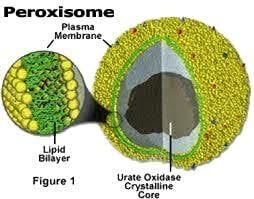
The structure of these peroxisomes is not easy to find, due to the small difference in density with lysosomes. Because of this, an injection was then carried out using Triton WR-1339 detergent and also continued with an electron microscope (Bianch and Sheeler, 1980; Kleinsmith and also Kish, 1988).
The results of this injection indicate that peroxisomes have a unique character. Small like a ball, has a size between mitochondria and ribosomes. Due to their small size, about 0.2 – 2 m, these peroxisomes are grouped into micro objects.
Peroxisome Function
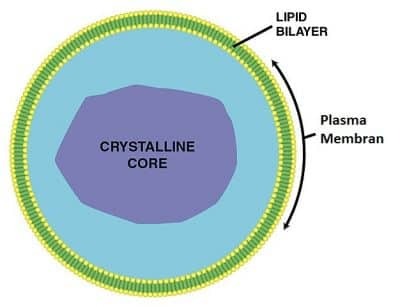
Its main function is to simplify a long fatty acid by beta-oxidation.
When in animal cells, the fatty acids produced will be long to form medium chains, which after that it will be carried to the mitochondria and ends with being broken down into carbon dioxide and carbon dioxide water.
The following are other functions of peroxisomes:
- As a producer of an enzyme catalase and also oxidase, which has or has a function to be able to move hydrogen from the substrate so that it can or can react with oxygen and can or can produce hydrogen peroxide or also H2O2 is as a producer of other.
- As a fuel for cellular respiration resulting from the breakdown of fatty acids into small molecular forms.
- In liver cells, this function can or can neutralize toxins caused by alcohol and other harmful chemical compounds.
The Role of Peroxisomes in Plant Cells
A plant expert from America, managed to find that there are 2 main enzymes that have an important role in plant peroxisomes, namely acid oxidase and catalase. The function is to help plants in a photorespiration process, along with other cell organelles such as, chloroplasts and mitochondria, which form a 3 in 1 cell network. This, of course, is why it is often observed that the three organelle cells are always close together.
Photorespiration is defined as respiration that occurs when lighting. According to the plant expert, states that the process of photorespiration in plants will take place simultaneously with normal respiration.
The difference is the response to oxygen in the external atmosphere, which in normal respiration is saturated with oxygen as much as 2%, while for photorespiration it will continue to increase until the oxygen produced reached 21%.
If in plant photosynthesis RuBP combines with carbon dioxide, it will produce 2 molecules of phosphoglyceric acid. However, when the RuBP combines with oxygen, it will then produce a molecule of phosphoglycerate. Furthermore, this phosphoglyceric acid undergoes a dephosphorylation reaction by the phosphatase enzyme which forms glycolic acid.
The formation occurs in a chloroplast, which then the glycolate will then move towards the Peroxisomes are then oxidized by glycolate oxidase to produce glyoxylate and hydrogen peroxide. Furthermore, the hydrogen peroxide will be broken down into oxygen and water by catalase. Some of the glyoxylic acid will then produce glycine acid.
After that, the 2 glycine acids will combine in the mitochondria to form serine acid and carbon dioxide. The reactions caused by these enzymes are the main source of photorespiration of carbon dioxide. After that, the serine will return to the peroxisome by going through all kinds of reactions to form glycerate. Glycerate in the chloroplast will be assisted by the enzyme glycerate kinase and 1 molecule of ATP, to form 1 molecule of phosphoglyceric acid and 1 molecule of ADP.
Characteristics of Peroxisomes
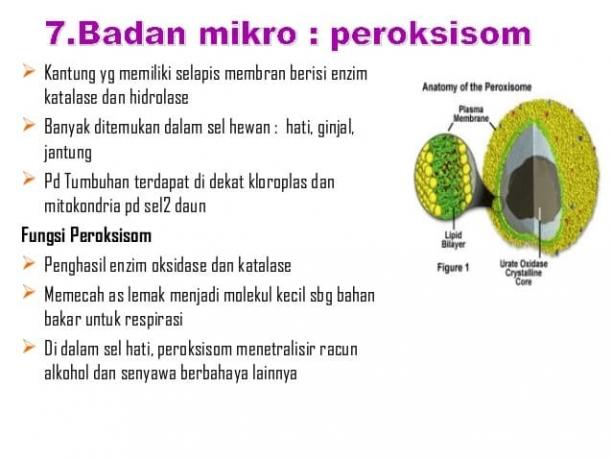
In its characteristics or characteristics, peroxisomes use oxygen and hydrogen peroxide in carrying out oxidative reactions. The enzymes in the peroxisomes will then use molecular oxygen to release hydrogen atoms from certain organic substrates.
Furthermore, the hydrogen peroxide will be used by catalase to oxidize other substrates, such as alcohol, phenol, formic acid, and formaldehyde. This reaction certainly has a role as a detoxification of toxic molecules in the blood.
Below is the complete reaction according to Giese, 1974.
RH2 + O2 → R + H2O2
H2O2 + H2O2 → O2 + 2 H2O (i.e. catalytic form)
catalase
RH2 + H2O2 → R + 2 H2O (ie peroxidatic form)
catalase
Reactions in Peroxisomes
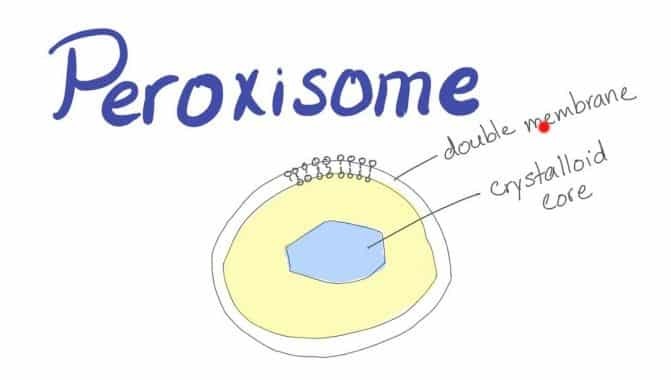
The peroxisome uses oxygen (O2) and hydrogen peroxide (H2O2) in carrying out oxidative reactions. Then the enzymes that are in the peroxisomes can or can utilize an oxygen molecule so that they can releasing hydrogen atoms received from certain organic substrates (R) in an oxidative reaction producing hydrogen peroxide (H2O2).
In the catalase enzyme by utilizing H2O2 it can or can oxidize other substrates (for example, such as formic acid, formaldehyde, phenol, and alcohol).
In this oxidation reaction, it plays a very important role in detoxifying all kinds of toxic molecules in the blood. So if there is a buildup of H2O2 then after that it will then be converted by catalase into O2.
One of the most important functions of this oxidative reaction is for a breakdown of fatty acid molecules in a process called beta-oxidation.
Peroxisome formation
There are two theories that explain how peroxisomes are formed and produced by cells. The first theory, called the classical model, states that these peroxisome proteins are synthesized with the help of ribosomes attached to the endoplasmic reticulum, after which the protein The peroxisomes enter the cisternae of the endoplasmic reticulum and form a sac (tail) which then shrivels and eventually separates to form free peroxisomes.
This second theory states that these peroxisomal proteins are synthesized with the help of free ribosomes, then the peroxisomal protein is then released into the cytoplasm and also develops and becomes peroxisomes.
These peroxisomes may or may not originate from the endoplasmic reticulum as well as replicate by fission. These peroxisomes also have or have different compositions of these enzymes in different types of cells. This peroxisome matrix is then translated in the cytoplasm before being released. There are at least 32 peroxisome proteins called peroxins, which have a role in the peroxisome assembly process. The PEX5 peroxin, receptor protein, and the PEX7 peroxin transport peroxisomes (i.e. containing either PTS1 or the PTS2 amino acid sequence) and back into the cytosol. This mechanism is called the shuttle mechanism. Now, there is or has been evidence that this hydrolysis of ATP is required for the recycling of receptors to the cytosol.
Peroxisome Diversity
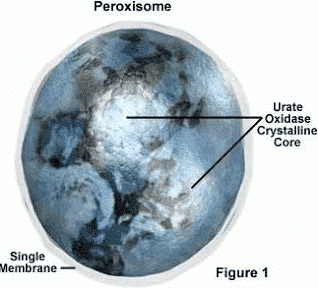
These peroxisomes have or have different enzyme compositions in different cell types. These peroxisomes are able to adapt to changing conditions or situations. For example, yeast cells grown in sugar have or have small peroxisomes, Meanwhile, yeast cells grown in methanol have or have large peroxisomes for oxidizing methanol. When yeast cells are grown in fatty acids, the peroxisomes enlarge to break down the fatty acids into acetyl-CoA through beta-oxidation.
Animal and Plant Cell Peroxisomes
In plants there are 2 kinds of peroxisomes while in animals there is only 1 kind of peroxisomes. One of the most important biosynthetic functions of animal peroxisomes is to catalyze the first reaction of plasmalogen formation. Plasmalogen is the most abundant type of phospholipid in myelin. The lack of plasmalogen then causes the myelin in the nerve cells to become abnormal, which is why the peroxisome damage leads to nerve damage.
Peroxisomes are also very important in plants. There are 2 types or types of peroxisomes that have been studied extensively. Type 1 is found in leaves, whose function is to catalyze the by-product of the CO2 binding reaction of carbohydrates, known as photorespiration. This reaction is called photorespiration because it uses up O2 and then releases CO2. Another type of peroxisome, it is found in germinating seeds. These second peroxisomes, known as glyoxisomes, have an important function in the breakdown of fatty acids, which are stored in seed fat, then become sugars needed for growth young plants.
The process of converting fat into sugar is carried out by a series of reactions called the glyoxylate cycle.
In the glyoxylate cycle, the 2 molecules of acetyl-CoA are generated from the breakdown of fatty acids, then they are used in making succinic acid. Furthermore, this succinic acid leaves the peroxisome and will then be converted into glucose. The glyoxylate cycle does not occur in animal cells. This causes the animal cells to be unable to convert the fatty acids into carbohydrates.
Photorespiration Reaction In Plant Cells
During photosynthesis, the CO2 is converted to glucose through the Calvin cycle, the first of which begins with the addition of the CO2 to the 5-carbon sugar, ribulose-1,5-bisphosphate. However, the enzymes involved in these reactions sometimes catalyze the addition of the O2 into ribulose-1,5-bisphosphate, which results in the production of compounds with 2 carbons, phosphoglycolate.
This phosphoglycolate is then converted to glycolate, which is then transferred to peroxisomes, where it is oxidized and converted to glycine. After that, the glycine is transferred to the mitochondria and converted to serine. The serine is then returned to the peroxisomes and converted to glycerate, which is then transferred back to the chloroplast.
Thus an explanation of the definition of peroxisomes, diversity, formation, reactions & functions, hopefully what is described can be useful for you. thank you
See AlsoDefinition of Mitochondria, Structure, Benefits and Functions
See AlsoUnderstanding Intranet, Functions, Benefits, Advantages and Disadvantages
See AlsoEnzymes Are: Definition, How it Works, Functions, and Properties
